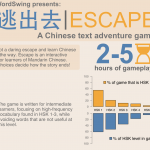Articles tagged with ‘Text games’
-
文字冒险游戏及其在对外汉语教学中的应用
Interactive text games work well for individual learners, but they are also excellent in
Read →
a classroom setting. This article gives you everything you need as a teacher to play Escape! in your classroom. This article is in Chinese, but there is an English version too. -
Text adventure games and how to use them in the Chinese language classroom
Interactive text games work well for individual learners, but they are also excellent in a classroom setting. This article gives you everything you need as a teacher to play Escape! in your classroom. A Chinese version of this article is available as well.
Read → -
Reading is a lot like spaced repetition, only better
Learning vocabulary through reading and by using spaced repetition software are both common strategies employed by students learning Chinese, but which one is the most efficient? In this guest article, Kevin Bullaughey from WordSwing compares the two methods in terms of exposure and coverage.
Read → -
How and why to learn and teach Chinese through games
This article is a follow-up to a keynote presentation and a workshop held at the 15th Annual Chinese Teaching Conference at University College London. Even though the original target group is teachers of Chinese, the article is relevant for students as well.
Read → -
New text game for Chinese learners: The Magistrate’s Gallery
The Magistrate’s Gallery is a new interactive text game for Chinese learners. A man knocks on your door with an unusual problem: his daughter has been trapped inside one of the paintings in the magistrate’s gallery. But which one? And how can you get her out? To rescue her, you will need to travel into the paintings and unravel the story about how the girl ended up there.
Read → -
Five text games for Chinese learners
This article is about five text games for Chinese learners. It both introduces the games and asks for feedback about how they can become even more engaging and fun. Each game contains on average roughly 10,000 characters, which makes them on par with a typical graded reader.
Read →




